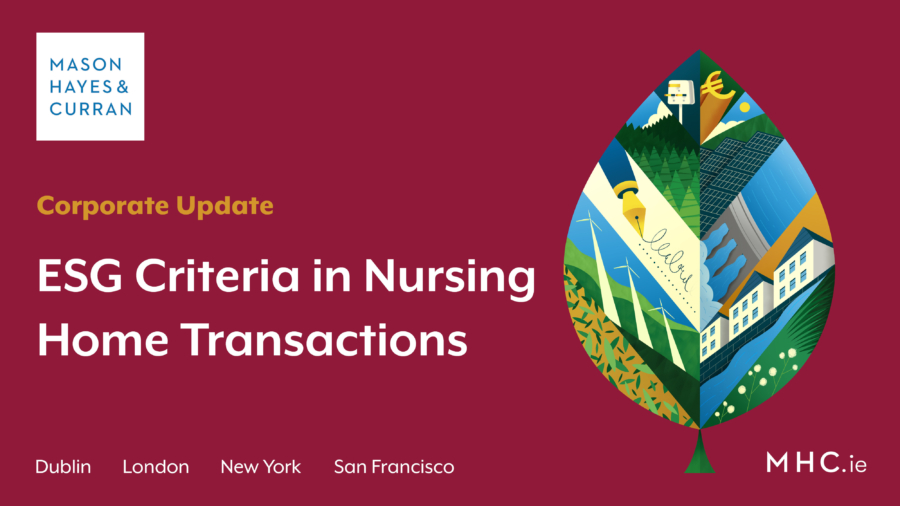
Environmental, Social and Governance (ESG) factors have risen in prominence in transactions in the healthcare sector and all businesses, including nursing homes, are expected to take proactive measures to improve their standing on ESG issues. The increased emphasis on ESG has refocused stakeholders to include ESG specific criteria when identifying and evaluating target nursing home assets and, in some instances, to create separate investment vehicles that focus solely on ESG-friendly businesses. Given the challenges facing the sector, it is important for owners and operators of nursing homes who wish to attract investors, purchasers and funders to actively pursue positive impacts in the ESG space and increase the value of their businesses and assets.
Historically, meeting ESG requirements might have been seen as a nice to have. However, today’s ESG conscious environment and government policy considerations mean that ESG criteria are a priority for many organisations. When owners of a nursing home or other designated centres seek to sell or develop their assets or look for funding or investment, the ESG footprint of the building, the ESG policies of the business and the behaviours of the board of directors will be assessed.
Operating businesses
It is advisable to align the ESG practices of the business with the interests of potential investors, purchasers and funders. Some examples of ESG practices adopted by the sector are set out below.
ESG Governance
Whether you run a single nursing home or are part of a wider group of nursing homes, the board of directors should have a good understanding and awareness of ESG issues. In the larger nursing home groups, it is advisable for the board of directors to comprise directors with knowledge of ESG matters or for a non-executive director with specific ESG expertise to be appointed to enhance the board’s capabilities in this area.
Regardless of the composition or size of the board of directors, the responsibility of the directors to facilitate the overall development of ESG within the business should be set out clearly. The full board may be involved or it may set up a committee or sub group to deal with specific areas of focus. Sometimes, businesses engage an ESG consultant to assist or provide guidance to the board.
From our experience, it is advisable for nursing home operators to identify realistic short and long term ESG goals and which may change and develop over time and depend on the resources available.
Identifying ESG Risks
Every nursing home business is well-advised to implement policies and systems to identify, access and manage ESG risks. Following the COVID-19 pandemic, improved practices and reporting of risks are now common across the sector. Some specific ESG issues for nursing home operators to identify and risk assess include:
- Corporate governance
- Business behaviours and practices
- Community issues and relations with residents’ families
- HR relations
- Human rights
- Health and safety
- Environmental
ESG Reporting
A nursing home business regularly makes decisions on energy and utility matters, healthcare products and supplies, consumables, recycling and waste products and services, financing, resident care, health and safety matters and in relation to employees. ESG considerations can play an important part in the decision making process, whether consciously or subconsciously.
With the increased focus on ESG policy and practices, it is becoming more important for operators to elevate a nursing home's chains of supply and to evaluate the quality of ESG reporting. On an ongoing basis, nursing home operators are advised to record how decisions on ESG related matters are made by the board of directors and its operating teams.
Nursing home buildings
New-builds and existing buildings bring their own unique challenges and opportunities to meet ESG criteria.
New-build projects in the real estate market can use a range of tools to achieve, demonstrate and certify ESG performance. For example:
- Voluntary sustainability certification schemes, such as LEED, will be especially familiar to the built environment sector participants. In addition to energy performance, these schemes increasingly account for systemic and contextual sustainability metrics. These include buildings’ connection with sustainable transport infrastructure and the GHG emissions attributable to their construction, or “embodied carbon”. The latter is increasingly measured using standardised tools such as the Embodied Carbon in Construction Calculator, or “EC3”.
- Similar tools are less well known but also available for buildings’ social, health and well-being impacts. The WELL building standard is becoming widely recognised and accounts for diverse factors impacting the health and holistic well-being of occupants. Particularly in a digitalised economy with flexible work arrangements, occupant-centric design can be a significant value driver for commercial real estate.
- Questions of corporate governance—the “G” in ESG—do not always fall squarely within the scope of property transactions. However, responsible governance is essential for collecting and reporting reliable data on ESG performance. Frameworks such as GRESB’s can help standardise and validate such reporting. This allows asset managers to identify and invest in genuine ESG-promoting real estate assets.
Certification schemes are also applicable to the occupation, upgrading and fitting out of existing buildings. Tools such as the Arc Platform can also measure and certify the actual environmental performance of a building as occupied, rather than its theoretical design performance.
Landlords and tenants can harness tools to engage in ESG-related collaboration for existing commercial premises. Green leases can facilitate varying levels of commitment towards data sharing and sustainable occupation and alteration of premises. While currently less prominent in the industry, we also anticipate that analogous approaches will be increasingly common for promoting or improving occupant well-being and other social impacts.
A challenge in this area is that it can be impractical or undesirable to make certain parties liable for improvements, whether directly or indirectly. The market trend, however, is for a significantly increasing standard of commercial premises. In certain circumstances, landlords and tenants might view improvements as necessary to futureproof the value and viability of premises. Green leases and similar tools can accordingly be used to calibrate parties’ ESG commitments proportionately and pragmatically.
Conclusion
The nursing home sector will play an increasingly important role in the future as demographic trends continue and populations grow older.
There are a range of important ESG considerations for the nursing home sector whether they are executing transactions or in reporting and communicating ESG credentials.
It is worthwhile for nursing home operators to be strategic about ESG to increase the value of their businesses. Employees, residents and their families and the public are increasingly interested in knowing about ESG practices in nursing homes and business who fail to consider and adopt good ESG practices may come under scrutiny.
Our Corporate and Real Estate teams can help advise and answer queries on these matters.
The content of this article is provided for information purposes only and does not constitute legal or other advice.
Share this:







